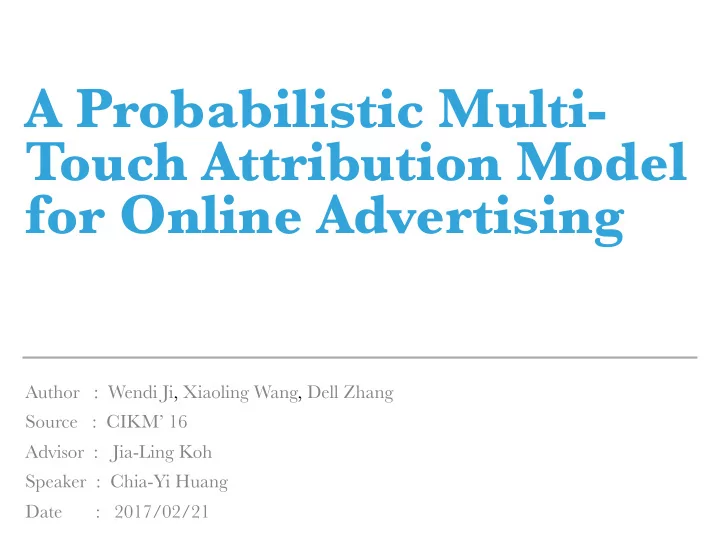

A Probabilistic Multi- Touch Attribution Model for Online Advertising Author : Wendi Ji, Xiaoling Wang, Dell Zhang Source : CIKM’ 16 Advisor : Jia-Ling Koh Speaker : Chia-Yi Huang Date : 2017/02/21
Outline ▸ Introduction ▸ Method ▸ Experiment ▸ Conclusion 2
Introduction 3
Introduction ▸ Probabilistic Multi-Touch Attribute ▸ Whether a user will convert ▸ When she will convert 4
Introduction ▸ Survival Analysis ▸ Survival function( ⽣甠存函數 ) : S(t) = Pr(T>t), T 為⽣甠存時間 , t 為某個時間 ▸ Lifetime distribution function( 衍⽣甠函數 ) : F(t) = 1 - S(t) = Pr(T <= t) ▸ Hazard function( 危險函數 ) : λ (t) = F’(t) / S(t) 5
Outline ▸ Introduction ▸ Method ▸ Experiment ▸ Conclusion 6
Method ▸ Weibull Distribution ▸ When α < 1, the hazard rate is a monotonic decreasing function. ▸ When α = 1, the hazard rate is a constant over time 1/ λ ▸ When α > 1, the hazard rate is a monotonic increasing function 7
Method ▸ Weibull Distribution 8
Method ▸ Probabilistic Model ▸ User => {1,…,U} ▸ Advertising Channels => {1,…,K} ▸ Browsing path b u of user u => ▸ l u : length of the ad browsing path b u ▸ : set of features whether conversion occurred when conversion occurred 9
Method ▸ Probabilistic Model ▸ : advertising channel ▸ : timestamp of click / impression ▸ : 1 is conversion has occurred , 0 o.t.w ▸ : last timestamp of the observation window ▸ : = 1, timestamp of the conversion occurred ▸ : 1 is conversion will happen , 0 o.t.w ▸ : conversion delay of an ad exposure ▸ : the elapsed time 10
Method ▸ Probabilistic Model ▸ When Y = 1 11
Method ▸ Probabilistic Model ▸ When Y = 1 Train 12
Method ▸ Probabilistic Model ▸ When Y = 1 Train 13
Method ▸ Probabilistic Model ▸ When Y = 0 14
Method ▸ Probabilistic Model ▸ When Y = 0 ▸ Y = 1 + Y = 0 15
Method ▸ Parameter Estimation ▸ Multi-Touch Attribution 16
Method ▸ Conversion Prediction 17
Outline ▸ Introduction ▸ Method ▸ Experiment ▸ Conclusion 18
Experiment ▸ DataSet ▸ A large real-world dataset provided by Miaozhen, a leading marketing company in China. ▸ The timestamp, the user ID, the channel ID, the advertising form, the website address, the type of operation system and browser, etc. ▸ 1.24 billion data records ▸ 59 million users(0.01% convert) and 1044 conversions available. ▸ Involved 2498 channels with 40 forms (e.g. iFocus, Button, Social Ad) and 72 websites (e.g. video websites, search engines, social networks) 19
Experiment ▸ Baseline ▸ AdditiveHazard ▸ Simple Probability ▸ Time-aware ▸ Logistic Regression 20
Experiment ▸ Conversion Prediction 21
Experiment ▸ Conversion Prediction included 22
Experiment ▸ Conversion Prediction 23
Experiment ▸ Attribution Analysis 24
Experiment ▸ Attribution Analysis 25
Outline ▸ Introduction ▸ Method ▸ Experiment ▸ Conclusion 26
Conclusion ▸ The PMTA model for conversion attribution which takes into account both the intrinsic conversion rate of a user and the conversion delay. ▸ The PMTA model can be applied to conversion prediction. ▸ The PMTA model is fitted to the observed data (conversion rate and conversion delay) rather than relying on simplistic assumptions. ▸ The PMTA model has been evaluated on a large real-world dataset. 27
THANK YOU
Recommend
More recommend